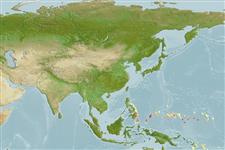>
Gobiiformes (Gobies) >
Gobiidae (Gobies) > Gobiinae
Etymology: dabra: Named for David Winterbottom and Bradley Hubley, an arbitrary combination of letters, 'dabra'.
Eponymy: This is an arbitrary combination of letters combining the first few letters of the given names of Winterbottom’s son, David, and of Bradley Hubley who is entomology collection manger in the Department of Natural History at the Royal Ontario Museum. [...] (Ref. 128868), visit book page.
More on author: Winterbottom.
Environment: milieu / Zona climática / intervalo de profundidade / distribution range
Ecologia
marinhas associadas(os) a recifes; intervalo de profundidade 0 - 24 m (Ref. 55341). Tropical
Western Pacific: currently known only from Palau.
Tamanho / Peso / Idade
Maturidade: Lm ? range ? - ? cm
Max length : 1.9 cm SL macho/indeterminado; (Ref. 55341); 1.8 cm SL (female)
Descrição suscinta
Chaves de identificação | Morfologia | Morfometria
Espinhos dorsais (total) : 6 - 7; Raios dorsais (total) : 7 - 10; Espinhos anais: 1; Raios anais : 7 - 9. Distinguished from its congeners in having a strong dark bar on the body, beginning just anterior to the origin of the first dorsal fin and passing ventrally just behind the base of the pectoral fin; about equal in width to the eye diameter. It has a dark anteroventrally-directed wedge-shaped bar from the eye to the jaws; a similar, but better developed postero-ventrally-directed bar from the eye to the vicinity of the vertical limb of the preopercle; a small dark blotch spot or bar on the anteroventral margin of the opercle. There is a black blotch at the middle length of the upper pectoral fin rays (Ref. 55341).
Body shape (shape guide): fusiform / normal.
Ciclo de vida ou comportamento de acasalamento
Maturidade | Reprodução | Desova | Ovos | Fecundidade | Larvas
Winterbottom, R., 2005. Feia dabra, a new species of gobiid fish Acanthopterygii: Perciformes) from Palau. aqua, J. Ichthyol. Aquat. Biol. 10(2):45-50. (Ref. 55341)
Status na Lista Vermelha da UICN (Ref. 130435: Version 2025-1)
Ameaça para os humanos
Harmless
Uso pelos humanos
Ferramentas
Relatórios especiais
Baixar XML
Fontes da internet
Estimates based on models
Preferred temperature (Ref.
123201): 28.8 - 29.4, mean 29 °C (based on 150 cells).
Índice de diversidade filogenética (Ref.
82804): PD
50 = 0.5312 [Uniqueness, from 0.5 = low to 2.0 = high].
Bayesian length-weight: a=0.01023 (0.00477 - 0.02194), b=3.01 (2.83 - 3.19), in cm total length, based on LWR estimates for this (Sub)family-body shape (Ref.
93245).
Nível Trófico (Ref.
69278): 3.0 ±0.3 se; based on size and trophs of closest relatives
Resiliência (Ref.
120179): Elevada, tempo mínimo de duplicação da população menor que 15 meses (Preliminary K or Fecundity.).
Fishing Vulnerability (Ref.
59153): Low vulnerability (10 of 100).
🛈
